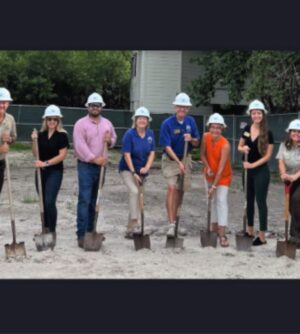The J.N. “Ding” Darling National Wildlife Refuge and “Ding” Darling Wildlife Society-Friends of the Refuge has broken ground on the latest refuge educational facility. The Roost, a $1 million-plus project, will welcome visitors to outdoor flex space for a broad spectrum of educational purposes by January 2024.
Construction on the accessible, inclusive, safe pavilion is now underway, adjacent to the entrance ramp to the “Ding” Darling Visitor & Education Center.
“Ever since COVID hit, open-air space for refuge programming has become a top priority,” said DDWS Executive Director Birgie Miller. “We have raised most of the funds to get started on the project, but we are still looking for at least another $100,000 to bring The Roost up to the highest standards of green construction and operation and to support its programming.”
The 2,590-square-foot pavilion, designed by Sanibel Island architect Amy Nowacki, will be constructed of innovative earth-friendly materials with solar panels that will provide electricity for its lighting, paddle fans, and other program needs. Incorporating design elements from nature, it will serve as an outdoor classroom for visiting school and other groups. DDWS also foresees creative new uses that reflect the refuge’s arts legacy and experiential mission, including music and artist events, puppet shows, lectures, mindfulness classes, and culture-driven programs.
The larger of the two covered, open-sided spaces will measure 1,200 square feet with removable seating. Three separate, 80-square-foot areas will accommodate small-group gatherings and places for visitors to gather and rest on their own while they explore the refuge. The structure also includes an 1,150-square-foot uncovered deck.
“Its name, The Roost, alludes to the pavilion’s welcoming appeal,” said Supervisory Refuge Ranger Toni Westland, who led the design and programmatic plans along with DDWS Associate Executive Director Sierra Hoisington. “Like the refuge’s rookery islands, it invites individuals of all types to a safe, easily accessible place to rest, soak up nature, and relax in the intrinsic beauty of the setting. It makes a perfect transition from the parking lot to the indoor Visitor & Education Center.”
As part of the project, the entryway kiosk will undergo a refresh, and DDWS is exploring opportunities for an electric-vehicle solar recharge station plus an electric vehicle to transport small-group tours. Interpretation will educate visitors about the importance of solar energy and other alternative energy sources.

